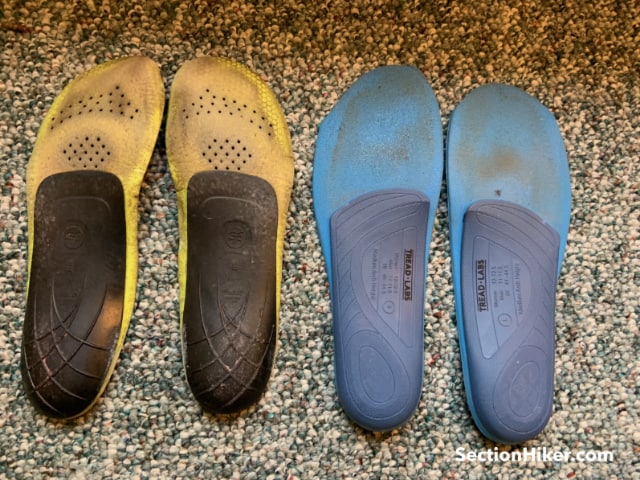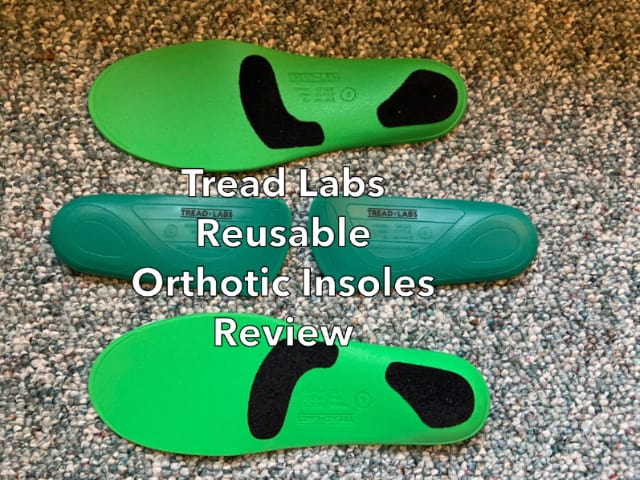Tread Labs’ orthotic insoles come in two pieces: a hard plastic arch support that also helps prevent plantar fasciitis and a replaceable fabric top cover that can be replaced when it wears out. This can save you a lot of money and cuts down on waste if you walk or hike a lot and use third-party insoles to protect your feet.
Tread Labs Stride Insoles
Innovation
Durability
Sizing
Lifetime Cost
Guarantee
Reusable Arch and Lower Cost
Tread Labs Stride Insoles come in two parts. A reusable plastic arch support with a lifetime guarantee and low-cost fabric cover that can be replaced when it wears out. This reduces plastic waste compared to regular insoles, while providing superior arch support, and costing much less than other 3rd party insoles products.
Specs at a Glance
- Sizes: Men’s (8-9.5, 10-11.5, 12-13.5) and Women’s (5-6.5, 7-8.5, 9-10.5)
- Arch Heights: Thin, Medium, High, Extra High
- Trim to Fit: Yes
- Antimicrobial treatment: Yes
The vast majority of running shoes, low hikers, mids, and hiking boots available today have really crappy foam insoles that wear out quickly and don’t provide any arch support (one notable exception are Oboz boots and shoes). It’s kind of scandalous that you have to pay extra for insoles when you consider how much hiking shoes and hiking boots cost.

Third-party insoles are needed by about one-third of hikers and backpackers. In addition to added arch support, they cup your heel to prevent it from pronating or supinating (turning in or out) which can lead to plantar fasciitis, a painful and debilitating inflammation of the foot arch that can take months to heal.
What Tread Labs has done is to separate the hard plastic arch support from the fabric cover. The arch support never wears out, so there’s no point in ever throwing it out. Right? The molded arch supports are unconditionally guaranteed. Forever. While the interchangeable top covers are easy to replace, as often as you need. That cuts down on plastic waste and saves you a lot of money.
Tread Labs also sells a selection of different insole covers for different purposes. For example, I wear trail runners for hiking and need a very thin top cover like their Stride Thin so that my toes don’t rub against the top of my shoes’ toe box. For my winter boots, I can use the thicker Stride Insole and top covers which provides more insulation and cushioning. Tread Labs even makes Stride Short Insoles and top covers for shoes that don’t come with removable inserts like women’s flats and men’s dress shoes. My wife likes those for her shoes.

For example, I go through four pairs of SuperFeet Carbon Insoles every year and it’s expensive to replace them at $55/pair and $210 for the year. Tread Labs sells their reusable orthotic insoles for $75/pair and replacement fabric top covers for $15/pair. If I purchased three pairs of replacement fabric top covers, my total annual cost would $120, which is over 40% less than using SuperFeet. That’s a pretty significant year one savings and it grows larger when you take it out across multiple years.
Recommendation
I am very cautious about changing my hiking footwear because I hike a lot and my feet are very sensitive when it comes to insole changes. But I haven’t experienced any problems switching from SuperFeet Carbon Insoles to the Tread Lab’s Stride Thin Insoles, which work just as well inside my low volume trail running shoes. Like any new insole, you need to let your feet acclimatize to the change and ramp up slowly by wearing them a few hours a day at first. But in addition to a lower cost over the long term, I really like the sustainability benefits of reusing the Tread Labs arch support and just replacing the top covers when they wear out, instead of throwing both out every time I blow through a top cover. Therefore, I’d recommend giving Tread Labs Stride Insoles a try if you want to save money and reduce waste. It’s a simple idea, but it has benefits for us all.
Tread Labs Insoles even come with a 30-day money-back guarantee, so there’s no risk in trying them out. Cool, huh?
Compare 1 Prices
Disclosure: The author received several pairs of insoles from Tread Labs in order to help a small manufacturer with new product testing and for review.
SectionHiker is reader-supported. We only make money if you purchase a product through our affiliate links. Help us continue to test and write unsponsored and independent gear reviews, beginner FAQs, and free hiking guides. SectionHiker.com Backpacking Gear Reviews and FAQs
SectionHiker.com Backpacking Gear Reviews and FAQs 


Gotta ask,
Do they come in different arch sizes?
Four arch heights. It’s all explained on their website or amazon.
Which arch height did you get to match the superfeet carbon insoles the best? The superfeet have a bit too high of an arch for me- wondering if the low arch of the Tread Labs would be less prominent?
I just picked a medium using the fitting directions on the Tread Labs website.
“The arch support never wears out”
Must be some new miracle plastic. I’ve worn custom orthotics without cushions or cloth for about 30 years. They get worn down by dust, grit, and gravel trapped in shoes. Eventually they become unusable. I get 5-10 years out of a pair.
While you might not replace these Tread Lab arch supports as often as Superfeet – you will replace them eventually.
That may well be. But as long as the company remains in business they’ll replace them for free. That’s their guarantee.
OK, I wear Superfeet Carbon’s and love them. My question to you is; in terms of comfort and performance, which do you prefer?
The top cover of the Tread Labs is more cushioned which makes them far more comfortable after walking over rocks all day in trail runners. So I’m liking them more than the Carbons along that dimension. Otherwise, they’re virtually indistinguishable.
I removed the fabric top from a pair of superfeet carbon insoles and put them under the factory insoles of my, Brooks Cascadias. I’ve gone through 5 pairs of shoes and have had success with over 2,500 miles and counting.
My biggest question is how you managed to get 500 miles out of a pair of Brooks Cascadias!
Well my partner squeezed those same miles or of a pair of Altas, the Brooks looked really good in comparison!
I’ve been using a single pair of Tread Labs Strides for probably 7-8 years, and they’ve been great. After trying all the usual brands, these are my go to’s.
I am using Tread Labs Pace Thin (high arch) in my shoes. I purchased the original Tread Labs Stride insoles then decided to try less cushioning, since they felt too “squishy” to me, so I ordered just the top covers. So far this seems to be the best setup for me.
After many years of Superfeet Green in hiking boots and Orange in shoes, I find the Tread Labs better for me. I briefly tried Superfeet Trail Blazers, but ended up returning them. That said, the Tread Labs definitely required a period of adjustment and they feel nothing like the Superfeet that I have used.
I gain better support and stability from the tread Labs insoles than i did from the Superfeet, so I am completely sold on them and do not expect to ever replace anything but the top covers.
Hi Philip,
I recently have come down with plantar fasciitis and was looking for some aftermarket insoles to help with recovery and prevention in the future. Are these still working for you? Have you become a convert over Smartfeet?
Any other tips you’d recommend for recovery and pain management of PF while out on the trail as well? I’m hopeful this won’t slow me down for long and know you’ve been a sufferer in the past.
I still use these and Superfeet (I have many pairs of boots, work boots, XC boots, fishing boots, etc) and they work fine for PF prevention. Pain management – Ibuprofen for a couple of months. Compression socks are also very helpful for increasing blood exchange in your feet to promote healing. Unfortunately, you really should stop hiking for 1-2 months to let the injury heal. I know that’s tough, but it will speed things up. Hiking with PF is pointless. You won’t heal.
Thanks Philip! Appreciate the recommendations and the tough but honest advice. Hopefully I’m back in action soon!
I had never heard of plantar fasciitis until I got my extremely painful introduction to it about fifteen years ago. The podiatrist prescribed silicone heel cups, which helped quite a bit. The doc charged me fifty dollars for a pair but the same product costs thirty online. I wore those cups a few years and also did stretching exercises every morning before I got out of bed. I haven’t had any issues with PF for more than a decade. I’ve been using custom orthotics for several years and no longer need the silicone inserts.
Hi Philip!
Have you had a chance to try the newer Tread Labs Dash line of carbon fiber insoles? How do they compare to your Superfeet carbons?
Not yet.
looks nice
I was very anxious about potential metatarsalgia on a hike of The West Highland Way with my daughter earlier this month. In the weeks leading up to it, I tried several different shoes and insoles. The combination I settled on was La Sportiva Ultra Raptors (a new pair from my “inventory” but not the latest version) and the TreadLab Ramble Thin insoles with a medium metatarsal pad in the left shoe. Excellent performance! I had maybe half a dozen twinges of MTA but nothing full-blown or hobble-inducing..
I now have zero metatarsal pain after switching to a treadlab sole and a met pad. It’s awesome.